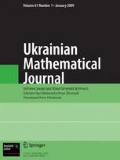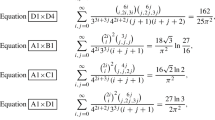Replacing the monomials by an arbitrary sequence in the recursive lemma found by Bressoud (1983), we establish several general transformation formulas from unilateral multiple basic hypergeometric series to bilateral univariate ones, which are then used for the derivation of numerous multiple series identities of Rogers–Ramanujan type.
Similar content being viewed by others
References
A. K. Agarwal, G. E. Andrews, and D. M. Bressoud, “The Bailey lattice,” J. Indian Math. Soc. (N.S.), 51, 57–73 (1987).
A. K. Agarwal and D. M. Bressoud, “Lattice paths and multiple basic hypergeometric series,” Pacif. J. Math., 136, 209–228 (1989).
G. E. Andrews, “An analytic generalization of the Rogers–Ramanujan identities for odd moduli,” Proc. Nat. Acad. Sci. U.S.A, 71, 4082–4085 (1974).
G. E. Andrews, “Problems and prospects for basic hypergeometric functions,” in: R. Askey (editor), Theory and Application of Special Functions, Academic Press, New York (1975), pp. 191–224.
G. E. Andrews, “Multiple series Rogers–Ramanujan type identities,” Pacif. J. Math., 114, 267–283 (1984).
G. E. Andrews, “q-Series: Their development and application in analysis, number theory, combinatorics, physics, and computer algebra,” CBMS Region. Conf. Ser. Math., No. 66 (1986).
G. E. Andrews and R. Askey, “Enumeration of partitions: The role of Eulerian series and q-orthogonal polynomials,” in: M. Aigner (editor), Higher Combinatorics, Reidel, Dordrecht (1977), pp. 3–26.
G. E. Andrews, R. Askey, and R. Roy, Special Functions, Cambridge University. Press, Cambridge (1999).
G. E. Andrews and A. Berkovich, “The WP-Bailey tree and its implications,” J. London Math. Soc., 66, No. 3, 529–549 (2002).
G. E. Andrews, A. Schilling, and S. O. Warnaar, “An A 2 Bailey lemma and Rogers–Ramanujan-type identities,” J. Amer. Math. Soc., 12, No. 3, 677–702 (1999).
W. N. Bailey, Generalized Hypergeometric Series, Cambridge University Press, Cambridge (1935).
W. N. Bailey, “Series of hypergeometric type which are infinite in both directions,” Quart. J. Math., 7, 105–115 (1936).
W. N. Bailey, “Some identities in combinatory analysis,” Proc. London Math. Soc., 49, 421–435 (1947).
W. N. Bailey, “Identities of the Rogers–Ramanujan type,” Proc. London Math. Soc., 50, 1–10 (1948).
W. N. Bailey, “On the analogue of Dixon’s theorem for bilateral basic hypergeometric series,” Quart. J. Math., Oxford Ser., 1, 318–320 (1950).
W. N. Bailey, “On the simplification of some identities of the Rogers–Ramanujan type,” Proc. London Math. Soc., 1, 217–221 (1951).
D. M. Bressoud, “Analytic and combinatorial generalizations of the Rogers–Ramanujan identities,” Mem. Amer. Math. Soc., 24, No. 227, 54 (1980).
D. M. Bressoud, “On partitions, orthogonal polynomials and the expansion of certain infinite products,” Proc. London Math. Soc., 42, 478–500 (1981).
D. M. Bressoud, “An easy proof of the Rogers–Ramanujan identities,” J. Number Theory, 16, 235–241 (1983).
D. M. Bressoud, “Lattice paths and the Rogers–Ramanujan identities,” Number Theory, Madras, 140–172 (1987); Lect. Notes Math., 1395 (1989).
D. M. Bressoud, M. Ismail, and D. Stanton, “Change of base in Bailey pairs,” Ramanujan J., 4, No. 4, 435–453 (2000).
D. M. Bressoud and D. Zeilberger, “Generalized Rogers–Ramanujan bijections,” Adv. Math., 78, No. 1, 42–75 (1989).
L. Carlitz and M. V. Subbarao, “A simple proof of the quintuple product identity,” Proc. Amer. Math. Soc., 32, No. 1, 42–44 (1972).
R. Chapman, “A probabilistic proof of the Andrews–Gordon identities,” Discrete Math., 290, 79–84 (2005).
W. Chu, “Almost-poised hypergeometric series,” Mem. Amer. Math. Soc., 135, No. 642, 99+iv (1998).
W. Chu, “The Saalsch¨utz chain reactions and bilateral basic hypergeometric series,” Constr. Approxim., 18, No. 4, 579–597 (2002).
W. Chu, “The Saalsch¨utz chain reactions and multiple q-series transformations,” in: M. E. H. Ismail and E. Koelink (editors), Theory and Applications of Special Functions, Springer, (2005), pp. 99–122.
W. Chu, “Bailey’s very well-poised 6ψ6-series identity,” J. Combin. Theory (Ser. A), 113, No. 6, 966–979 (2006).
W. Chu, “Abel’s lemma on summation by parts and basic hypergeometric series,” Adv. Appl. Math., 39, No. 4, 490–514 (2007).
W. Chu, “Jacobi’s triple product identity and the quintuple product identity,” Boll. Unione Mat. Ital., B10, No. 8, 867–874 (2007).
W. Chu and Q. L. Yan, “Unification of the quintuple and septuple product identities,” Electron. J. Combinatorics, 14, No. 7 (2007).
W. Chu and W. Zhang, “Bilateral Bailey lemma and Rogers–Ramanujan identities,” Adv. Appl. Math., 42, 358–391 (2009).
S. Cooper, “The quintuple product identity,” Int. J. Number Theory, 2, No. 1, 115–161 (2006).
J. Fulman, “A probabilistic proof of the Rogers–Ramanujan identities,” Bull. London Math. Soc., 33, No. 4, 397–407 (2001).
F. G. Garvan, “Generalizations of Dyson’s rank and non-Rogers–Ramanujan partitions,” Manuscr. Math., 84, No. 3-4, 343–359 (1994).
G. Gasper and M. Rahman, Basic Hypergeometric Series, Cambridge University Press, Cambridge (2004).
B. Gordon, “A combinatorial generalization of the Rogers–Ramanujan identities,” Amer. J. Math., 83, 393–399 (1961).
F. H. Jackson, “Examples of a generalization of Euler’s transformation for power series,” Messenger Math., 57, 169–187 (1928).
C. G. J. Jacobi, Fundamenta Nova Theoriae Functionum Ellipticarum, Fratrum Borntr¨ager Regiomonti (1829); Gesammelte werke, G. Reimer, Berlin (1881), Bd 1.
J. Lovejoy, “Overpartition theorems of the Rogers–Ramanujan type,” J. London Math. Soc. (2), 69, No. 3, 562–574 (2004).
J. McLaughlin and A.V. Sills, “Ramanujan–Slater type identities related to the moduli 18 and 24;” J. Math. Anal. Appl., 344, 765–777 (2008).
J. McLaughlin and A.V. Sills, “Combinatorics of Ramanujan–Slater type identities,” Integers 9 Supplement, Art#10 (2009).
P. Paule, On identities of the Rogers–Ramanujan type,” J. Math. Anal. Appl., 107, No. 1, 255–284 (1985).
A.V. Sills, “On identities of the Rogers–Ramanujan type,” Ramanujan J., 11, No. 3, 403–429 (2006).
L. J. Rogers, “Second memoir on the expansion of certain infinite products,” Proc. London Math. Soc., 25, 318–343 (1894).
L. J. Rogers, “On two theorems of combinatory analysis and some allied identities,” Proc. London Math. Soc., 16, 315–336 (1917).
A. Selberg, “Über einige arithmetische identita¨ten,” Avh. Norske. Vidensk. Akad. Oslo l. Mat. Naturvidensk., Kl, 8, 2–23 (1936).
A. Schilling and S. O. Warnaar, “A higher level Bailey lemma: proof and application,” Ramanujan J., 2, 327–349 (1998).
A.V. Sills, “A partition bijection related to the Rogers–Selberg identities and Gordon’s theorem,” J. Combin. Theory (Ser. A), 115, 67–83 (2008).
U. B. Singh, “Certain bibasic hypergeometric transformation formulae and their application to Rogers–Ramanujan identities,” J. Math. Anal. Appl., 198, No. 3, 671–684 (1996).
L. J. Slater, “A new proof of Rogers’s transformations of infinite series,” Proc. London Math. Soc. (2), 53, 460–475 (1951).
L. J. Slater, “Further identities of the Rogers–Ramanujan type,” Proc. London Math. Soc. (2), 54, 147–167 (1952).
L. J. Slater, Generalized Hypergeometric Functions, Cambridge University Press, Cambridge (1966).
D. Stanton, “The Bailey–Rogers–Ramanujan group,” in: q-Series with Applications to Combinatorics, Number Theory, and Physics (Urbana, IL, 2000), 55–70; Contemp. Math., 291, American Mathematical Society, Providence, RI (2001).
J. R. Stembridge, “Hall–Littlewood functions, plane partitions, and the Rogers–Ramanujan identities,” Trans. Amer. Math. Soc., 319, 469–498 (1990).
S. O. Warnaar, “Supernomial coefficients, Bailey’s lemma and Rogers–Ramanujan type identities. A survey of results and open problems,” The Andrews Festschrift (Maratea, 1998); Séminaire Lotharingien de Combinatoire, 42, Art. B42n, 22 (1999).
S. O. Warnaar, “The generalized Borwein conjecture: I. The Burge transform,” in: q-Series with Applications to Combinatorics, Number Theory, and Physics (Urbana, IL, 2000), 243–267; Contemp. Math., 291, American Mathematical Society, Providence, RI (2001).
S. O. Warnaar, “The generalized Borwein conjecture: II. Refined q-trinomial coefficients,” Discrete Math., 272, No. 2-3, 215–258 (2003).
G. N. Watson, “A new proof of the Rogers–Ramanujan identities,” J. London Math. Soc., 4, 4–9 (1929).
G. N. Watson, “Theorems stated by Ramanujan: VII. Theorems on continued fractions,” J. London Math. Soc., 4, 39–48 (1929).
Author information
Authors and Affiliations
Additional information
Published in Ukrains’kyi Matematychnyi Zhurnal, Vol. 64, No. 1, pp. 100–125, January, 2012.
Rights and permissions
About this article
Cite this article
Chu, W., Wang, C. Iteration process for multiple rogers–ramanujan identities. Ukr Math J 64, 110–139 (2012). https://doi.org/10.1007/s11253-012-0633-1
Received:
Published:
Issue Date:
DOI: https://doi.org/10.1007/s11253-012-0633-1



